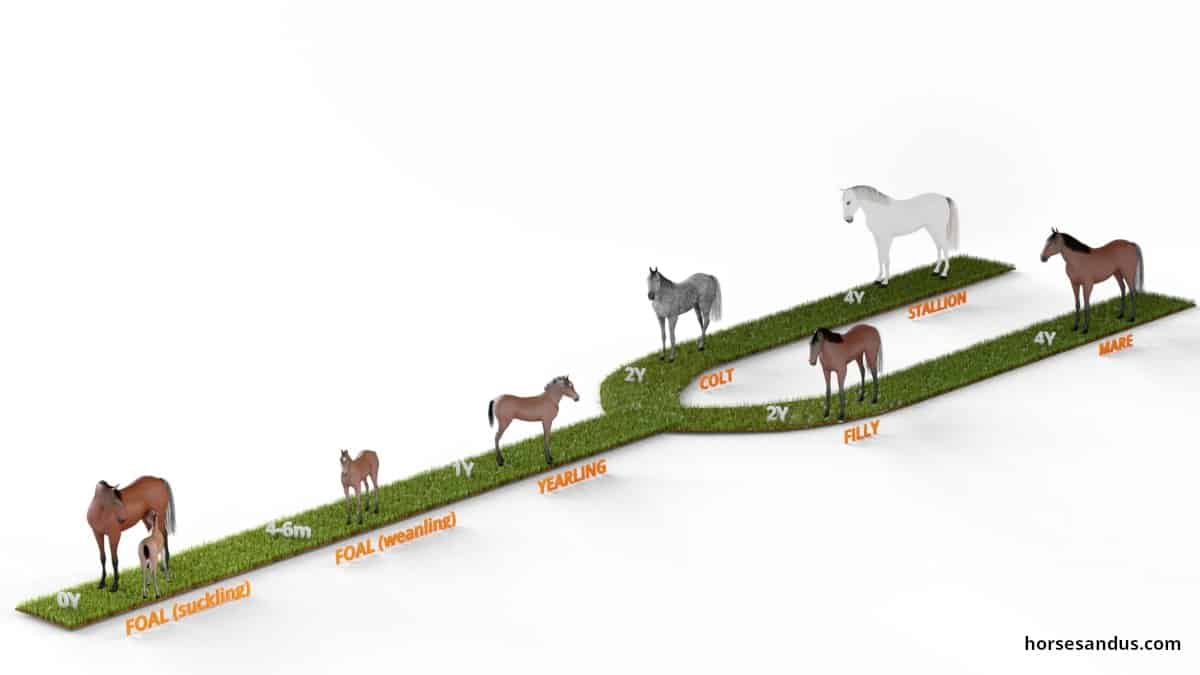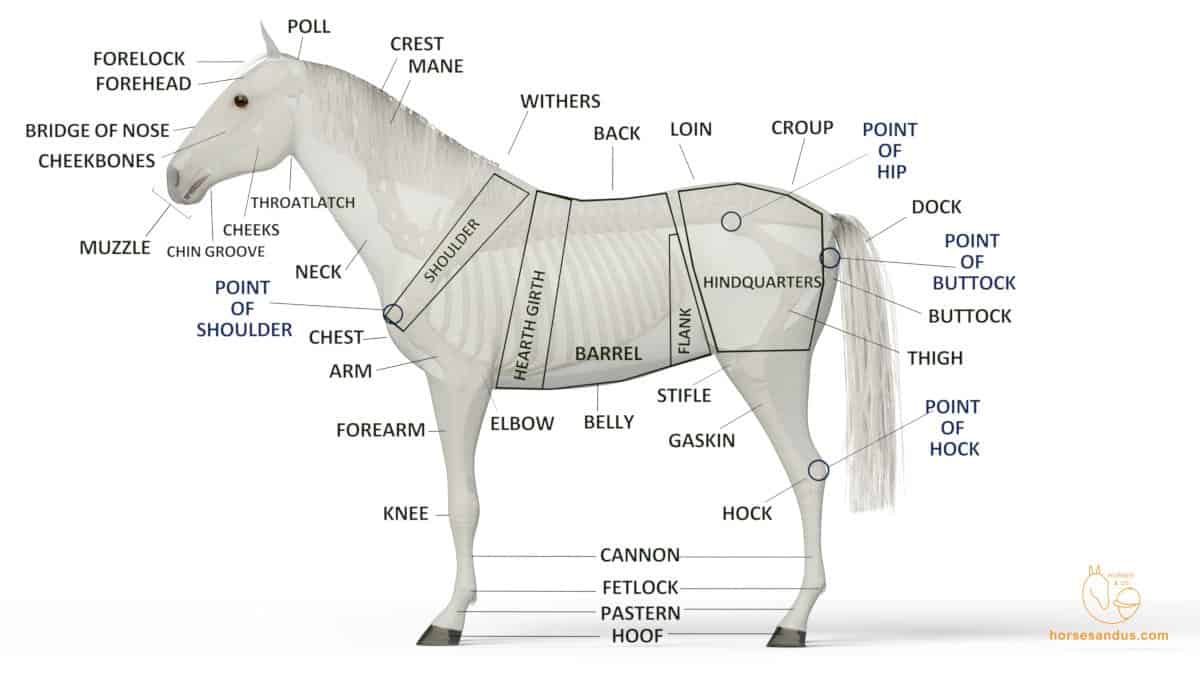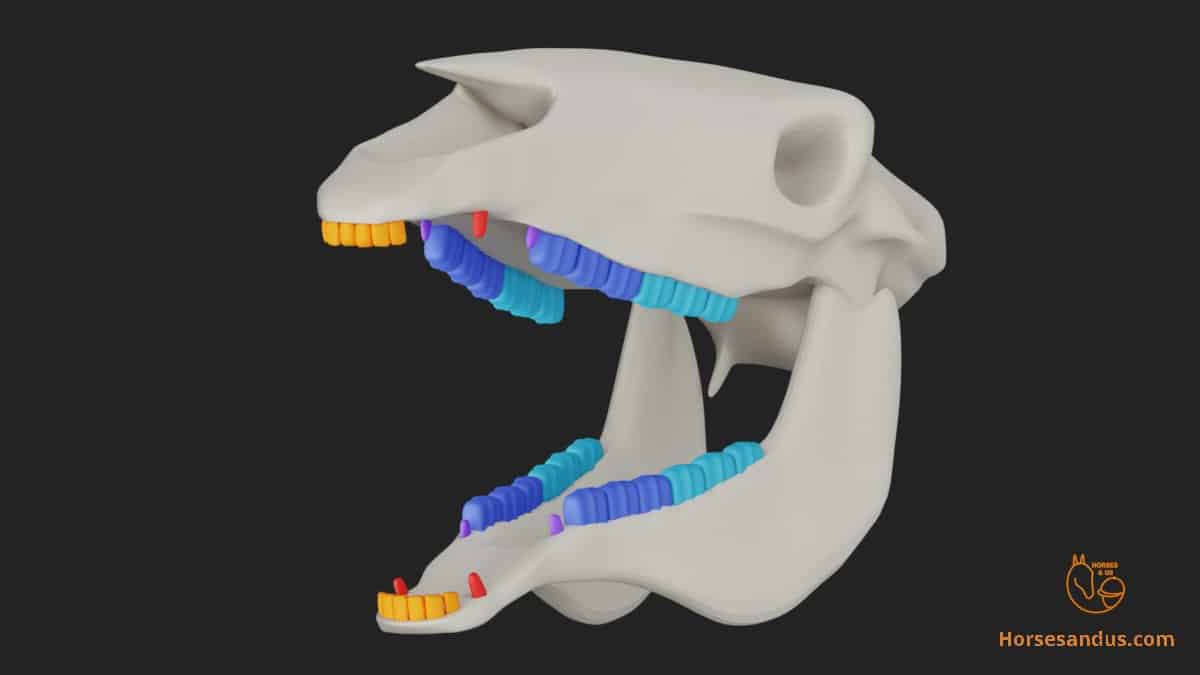We all have heard “no hoof, no horse.” So we know that taking care of our horse’s hooves is very important. We clean, trim, and shoe them regularly to keep them healthy and comfortable. But then we wonder about horses in the wild that do not have our help to care for their hooves. How do wild horses maintain their hooves?
Wild horses maintain their hooves by moving long distances, 20 to 40 miles (30 to 60 km) a day, over rough terrains. This keeps their hooves healthy by building hard hooves that do not need shoeing and wearing down (trimming) the hoof, which prevents overgrowth.
Additionally, natural selection only allows the survival of the fittest. So wild horses tend to have genetically healthier feet.
On the other hand, our domestic horses are not always born with good hooves because they are bred for other traits and do not have access to the same environment as wild horses, such as rough terrains and the possibility to roam for long distances. This results in more fragile hooves that need our care to keep them healthy.
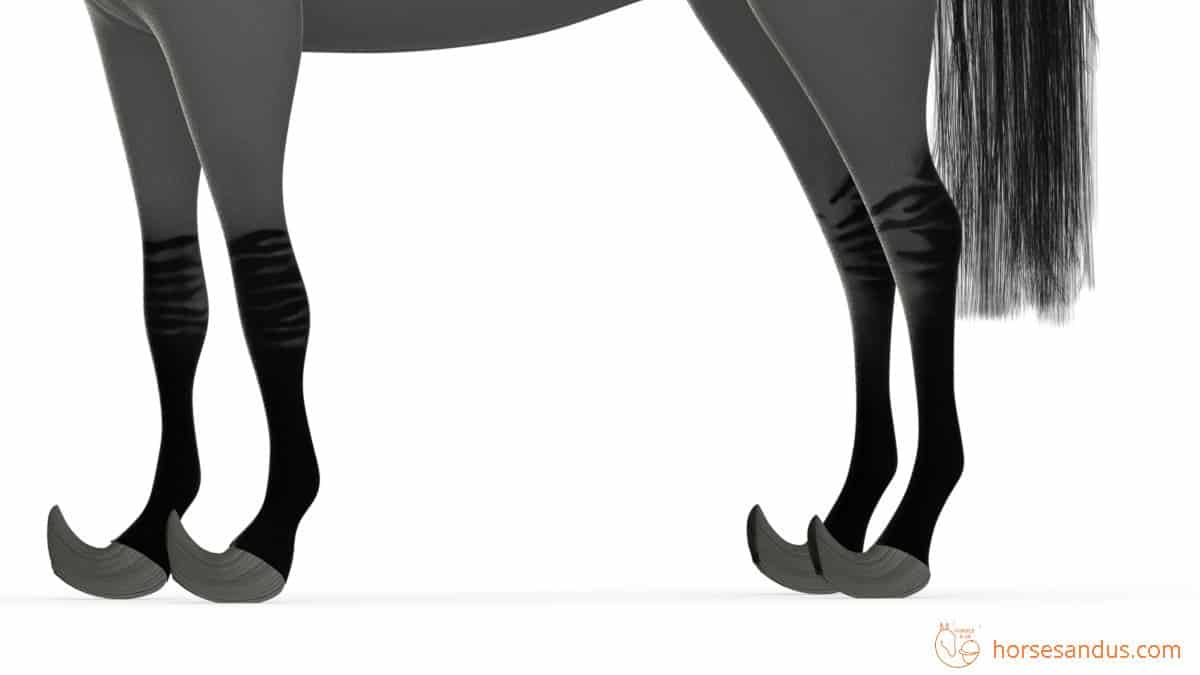
Wild Horse’s Hooves Are Different From Domestic Horse’s Hooves
Many people that are in favor of natural methods often compare domestic horses with wild horses. In the case of hooves, they may ask, “If wild horses don’t need shoes, then domestic horses also should not need them.”
But… we need to understand that there is a difference between the hooves of wild horses and domestic horses.
Wild horses live in a different environment, and also natural selection produces a genetically different hoof than the selection made by man.
Wild Horses’ Natural Selection
Throughout time, the horse´s hoof has evolved to adapt to its environment, allowing horses to survive more easily in the places where they existed. The horses that better survive due to their more adapted hooves will pass their genes to their offspring. This process causes the horse’s hooves to gradually change over time.
In wet, muddy areas, horses developed large flat hooves, while in harsh terrain, they developed small hard hooves.
Domestic Horses’ Human Selection
When man breeds horses he usually is not concerned with their survival in the wild. The most commonly desired traits are conformation, and performance capabilities for different sports. So the traits that give horses an advantage in the wild are not on top of the breeder´s priority list.
Throughout history man has altered horses through selective breeding and training.
Evidence of man´s influence can be seen in the structure of the hoof:
- Draft horses such as Clydesdale were bred to have large hard-wearing feet, which were necessary to pull heavy loads.
- Quarter horses were bred to have small delicate hooves because it was considered a desired conformational trait. This results in health issues like navicular disease.
- In show horse breeds, long hooves are desirable because they enable high flashy gaits.
The blow graph (source) shows the result of a study done in several countries to determine if hoof disorders were considered when selecting stallions for breeding.
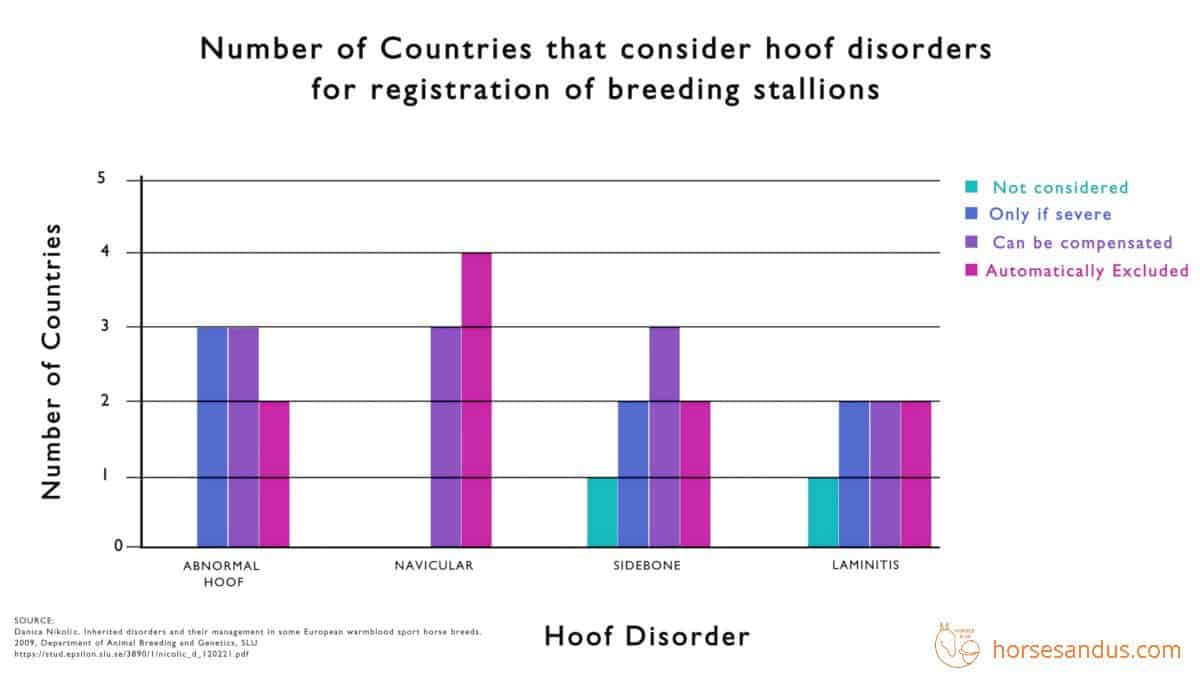
Wild Horses’ Natural Environment
The environment where wild horses live is an important contributor to the structure and maintenance of their hooves.
The morphology of the hooves is mainly affected by the type of ground and the distance that horses travel.
Different environments produce different types of hooves with specific health problems.
Hard Ground
In hard ground environments, there seems to be a balance between the wear and growth of the hoof wall. So hoof walls are short and rounded and usually worn down to the peripheral sole.

This rounded edge is commonly called a “mustang roll.” It keeps the breakover short, thus alleviating strain on the tendons and ligaments. It also prevents chipping and cracks to the hoof wall.
Soft Ground
In soft ground environments, the growth rate exceeds the wear rate of the hoof wall. So hoof walls are long and flared.

In the wild, a flared hoof wall will chip, form small cracks and break away. In domestic horses that do not walk enough to wear away the hoof, it needs to be trimmed.
Flares are painful. The horse’s hoof is like our fingernails. Flaring feels the same as if we had our fingernails pulled off.
Wild Horse’s Hooves can also have problems
However contrary to what some people believe, wild horse’s hooves do have health issues.
Studies (Brian Hampson, 2011. The effects of the environment on the feral horse foot.) have identified that although horses living in hard surface environments appear to have robust feet, they are subject to traumatic laminitis and concussive pathologies associated with this environment.
Nevertheless, they can withstand these foot health issues without showing lameness, which helps the horse survive in extreme conditions.
Domestic Horses’ Artificial Environment
Our domestic horses usually have weaker hooves than wild horses since they are mostly confined to stables or small paddocks that have softer and damper ground and limit their movement.
Due to this environment and lifestyle, domestic horses are unable to wear their hooves down. This is why they need to have their hooves trimmed by a farrier.
Also, with weak hooves, they cannot withstand moving long distances on hard terrain or doing intense exercise, and this is why they need to be shoed.
What Happens If Horse’s Hooves Are Not Trimmed?
If horse’s hooves are not trimmed, hoof overgrowth will occur. This will affect the horse in ways most people don’t suspect. It can lead to cracked or contracted hooves, thrushy frog, chalky sole, fractured quarters, demineralized coffin bone, inflamed joints, deformed bones, strained tendons and ligaments, muscle pain in the entire body, and more.
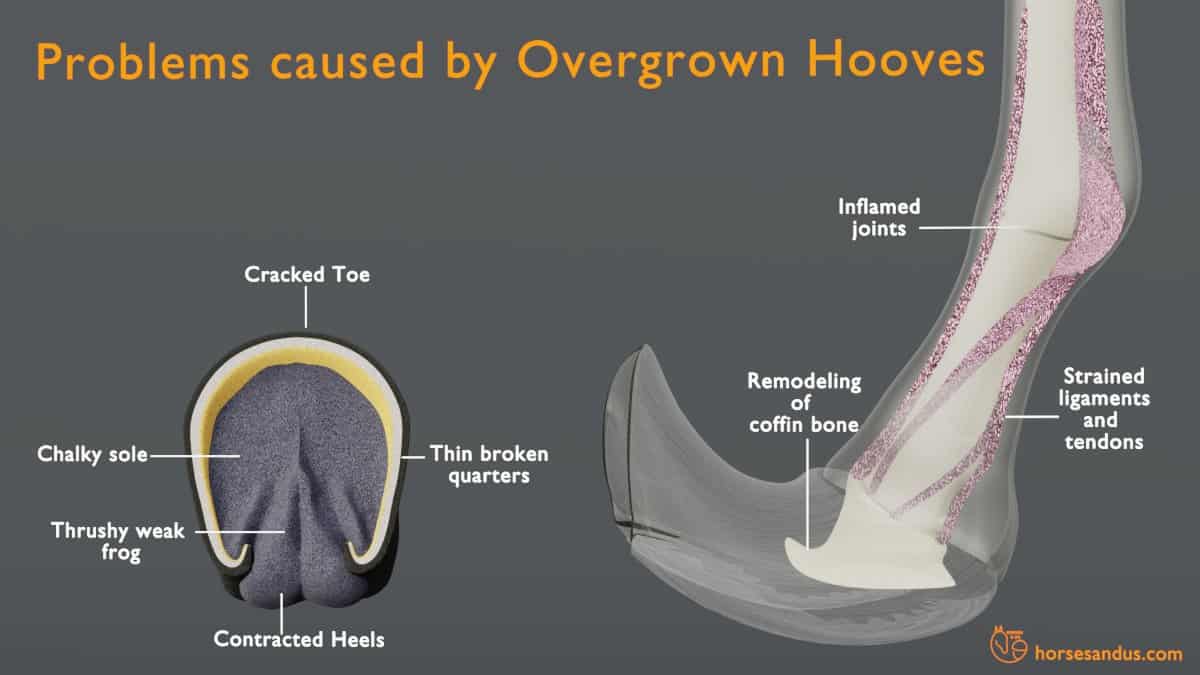
The problems that can result from overgrown hooves are the following:
Within The Hoof
- A long hoof wall will assume the weight-bearing function, while the sole and the frog lose their function and thus reduce the hoof mechanism of contraction and expansion as the horse walks.
- Contracted hooves that result from incorrect foot loading
- The frog becomes thrushy, weak, and overgrown
- The sole turns chalky, black and is not able to exfoliate.
- The quarters become thin and break in an attempt to put the frog back on the ground.
- The toe will eventually chip, crack and break away.
Beyond The Hoof
- Demineralization and remodeling of the coffin bone
- With overgrown hooves, the horse is forced to walk in an unnatural way to avoid pain, and consequently, the joints become inflamed, leading to arthritis and bone remodeling. Also, the ligaments and tendons become strained.
- Since it cannot walk properly, the horse tends to stand or lay down for long periods of time, which results in stiffening and weakening of tendons and ligaments.
- Seeking to avoid the pain, horses try to find alternative ways to walk, stressing other muscles in the shoulders, hips, and back. Ultimately the entire body is affected with pain.
Overgrown hooves are a common problem in rescue horses, which have been neglected for a long period of time. This article mentions an extreme case.
Does a Hoof Trim Hurt The Horse?
Trimming the hoof does not hurt the horse because the hoof wall is insensitive. It is made up of a tough protein called keratin, which is a dead tissue with no blood or nerve supply. It is the same as our fingernails, which are also made of keratin. When we cut our fingernails, it does not hurt. The same happens to the hoof wall of the horse.

However a hoof trim can cause pain in the horse if it is not correctly done.
The hoof has a conformation that is strong, protective and maximizes biomechanical efficiency.
If the hoof is not correctly trimmed, it will slowly distort and be put under abnormal pressure leading to hoof problems. This will affect the hoof wall and the internal structure of the hoof, such as the frog, digital cushion, heels, sole, and so on.
Examples of hoof problems that result from incorrect trimming are flaring, chipping, contracted heels, underrun heels, digital cushion and frog atrophy, inflamed joints, strained ligaments remodeling of the bones, and ultimately pain in the entire body.
Why wild Horses Don’t Need Shoes
In the wild, horses will roam for many hours every day, across rough terrain, searching for pasture. This constant movement on hard surfaces creates strong and healthy hooves. That is why wild horses don´t need shoes to protect their hooves.
This is similar to human foot calluses, i.e., the thickened skin that forms naturally when humans walk barefoot. Foot calluses were an evolutionary adaptation to protect the feet. Additionally, it provides comfort and sensitivity in a way that shoes can´t match.
Just like horses, humans walked barefoot for most of their existence:
- The earliest human footwear dates back to 8000 years ago.
- The earliest forms of horseshoes, “hipposandals,” date back to 2500 years ago
Why Domestic horses need Shoes
After the horse’s domestication, horseshoes were created to protect the hooves from the damage caused by the excessive burden humans put on the horse, such as walking for hundreds of miles, bearing the rider’s weight, pulling heavy wagons, and so on.
Then with the appearance of equine sports, horseshoes also became necessary. For example, horseshoes allow the horse to run faster while protecting the hoof from breakage.
Wild horses neither work for humans nor participate in sports, so their hooves are not subject to the strenuous efforts that our domestic horses are. This is another reason why wild horses do not need shoes.
However, domestic horses that are out in the pasture and do not work intensively also do not need shoes.
Sources
An overview of breeding objectives for warmblood sport horses
An article from https://www.easycaredownunder.com.au
Article from americanequus.com
Barefoot Walking Gives You Calluses That Are Even Better for Your Feet Than Shoes, Study Suggests
